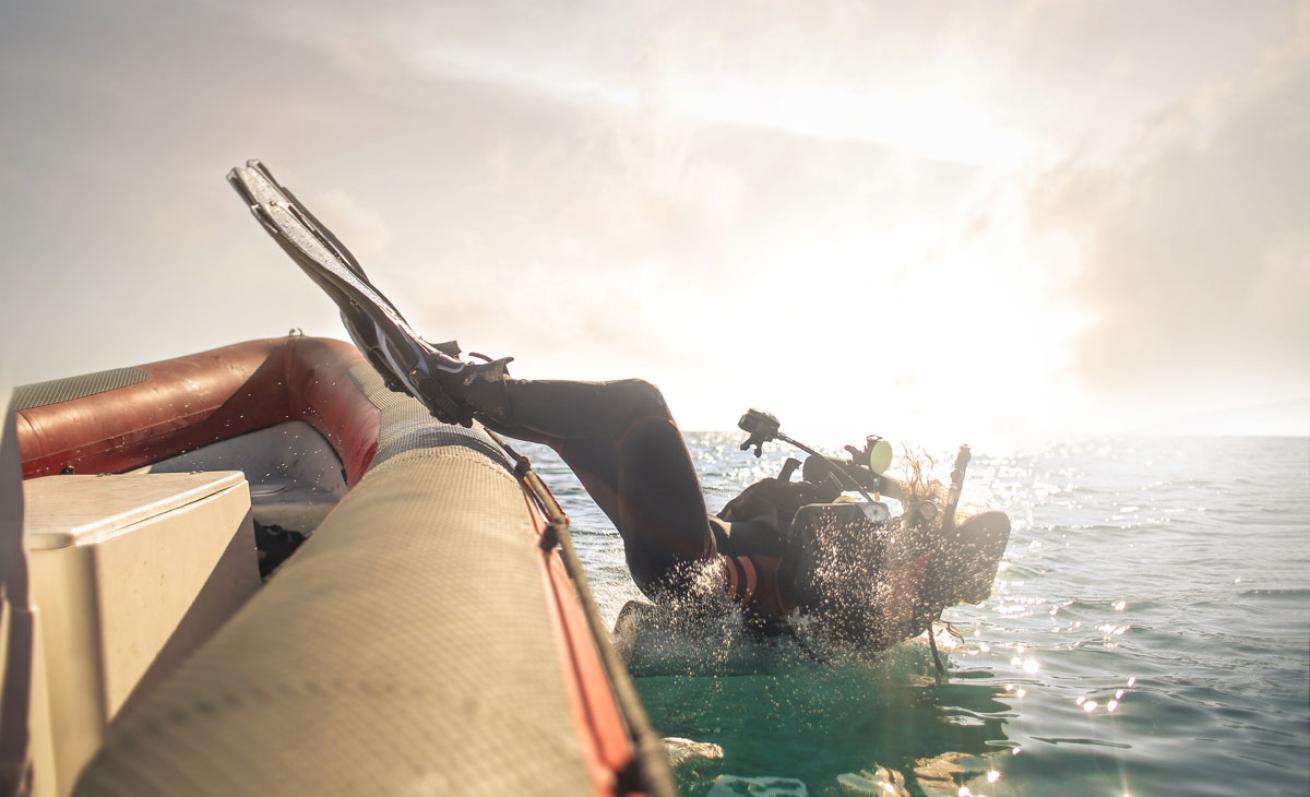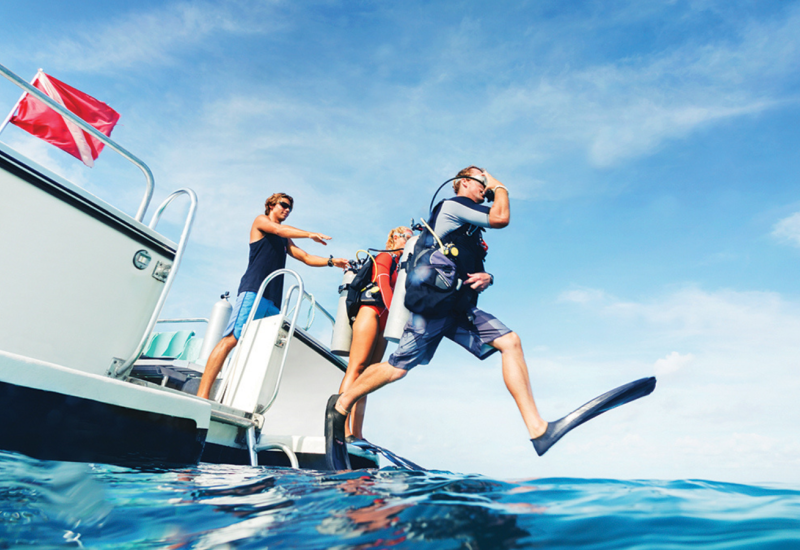10 Scuba Diving Safety Rules for Avoiding Emergencies
What causes dive fatalities? How can you avoid those mistakes? Here's a list of 10 causes for scuba diving emergencies and what you can do to prevent them.
10 Safety Rules to Live By

ShutterstockLearn how to avoid the most common diving mistakes.
RULE #1: Good Overall Fitness
Several studies have indicated that 20 to 35 percent of all scuba fatalities result from heart/circulatory problems. Prior lifestyle and medical conditions set the stage, while the mental and physical stresses of diving trigger the event, usually in middle-aged men. Because the accident occurs in or under water, it is usually fatal and often listed as a drowning.
Other fitness concerns include recent illness, the stresses of cold and fatigue, use of drugs and alcohol, and respiratory problems, including smoking. The keys to fitness are clear: eat well, exercise, get rest, and avoid stress and harmful habits. Easy to say, tough to do. What’s easy, however, is for all divers, especially middle-aged men, to have a regular medical exam to determine whether they’re fit for the stresses of diving. The small investment of time and money required for an annual physical is a big favor to yourself and everyone who cares about you-and could prevent as many as one-third of all scuba fatalities.
RULE #2: Dive with Others
Diving solo or separated from other divers does not cause accidents, but it does mean that if something goes wrong, additional help is not available. Diving on organized trips, with dive clubs or dive stores, from dive boats or dive resorts, in dive classes or under other supervision ensures that dive professionals and emergency support equipment are available if a problem arises. Experience clearly demonstrates that when a dive leader is present, a potentially fatal accident often becomes a near-miss or a lesser injury. Diving with support and supervision is particularly important when you are new to diving or have been away from diving for a while.
RULE #3: Know When and Where To Dive
Knowing when and where to dive takes skill and experience. One of the most important safety concepts is that every diver has a right to make a “no dive” decision at any time before or during a dive, and that other divers will respect this decision regardless of whether it is based on environmental conditions, fitness, equipment or the planned dive activity. The bottom line: Know when to say no; know when to say enough.
SEE MORE: Hand Signals Every Diver Should Know
RULE #4: Pause for Comfort and Safety
As divers, we learn many important diving practices, but they must be applied in a safe and sensible way. Surfacing slowly and under control is more important than returning to the boat with a certain amount of air left in your tank. We also learn to solve problems under water by stopping, breathing easy, getting under control, thinking, and then taking deliberate action. Let’s apply this thinking and skill not just to problem-solving, but also to problem prevention.
Every time you make a significant change during a dive — getting in or out of the water, going up or down — you should pause. Why? Your vision, respiration, heart rate, center of gravity, buoyancy, weight, hearing and body temperature change dramatically as you move up and down, and in and out of the water. The mind and body need time to process and react to these changes. A pause at each transition — to check yourself, your buddy, instruments and the environment — allows you to adjust to the changes and can prevent emergencies.
RULE #5: Breathe for Life
Breathing under water is the most important adaptive skill we learn as scuba divers. It deserves far more attention than the simple admonishment: “Never hold your breath.”
A case in point is over-breathing — demanding more from the regulator than it can supply. Over-breathing is implicated in a large number of diving accidents. On investigation, the regulator works within specifications, but the evidence suggests the diver was not getting enough air. What happened? Adapting successfully to scuba includes breathing in a slow, deep and relaxed manner, paying particular attention to a deliberate and complete exhale — even in stressful situations. Otherwise, the result could be over-breathing a regulator, no matter how good the manufacturer is or how well you’ve cared for it.
Another life-saving point: it is nearly impossible to be out of air, but you can be very low on air. This means that if you breathe gently and ascend, more air will become available (one of the reasons you should keep your regulator in your mouth during emergencies). Your power inflator will also work when you are sharing air with another diver because you’re low on air. Power inflators are simple on and off valves that equalize pressure between the tank and the BC, and at very low pressure they just do it slower.
Among the more preventable diver fatalities are the cases in which a tank valve is not turned completely on. If the tank valve is not completely open, the flow of air to the regulator is restricted and causes an apparent out-of-air situation, even though the pressure gauge shows plenty of air. The diver then over-breathes the regulator, panics and has a fatal accident. The best procedure is to open the tank valve gently until it stops.
READ MORE: How to Deal with Panic on a Dive
RULE #6: Relax and ##RULE #7: Retain Control
Control and relaxation are mental skills central to diving comfortably and confidently. In diving, you want your body and mind to work together because when you relax you think clearly, allowing you to maintain control by applying your training and experience. When divers begin to doubt their ability to handle a situation, the stress reduces clear thinking and control.
Therefore, as you learn as a beginning diver, when faced with a problem, stop, think, breathe, relax then act. These steps help you remain aware of the situation and think clearly, focusing on the details at the same time. With experience and additional training it becomes easier, and divers who do this seldom show up in the accident statistics.
RULE #8: Ascend with Control
Ascending slowly, under control and with a safety stop helps prevent decompression sickness (DCS), reduces the risk of lung overpressure injuries including air embolism (AGE), prevents buddy separation and duces the risk of colliding with a boat or other object.
A normal ascent should be made with neutral buoyancy, venting air from your BC or drysuit as you ascend, and a minimum of swimming, which reduces stress. Ascend at 30-feet per minute (10 meters) or slower if specified by your computer, and make a safety stop for three minutes (or longer if specified by your computer) at 15-feet (5 meters) Actually, a safety stop can be done anywhere from 10 to 30 feet and the appropriate length of time can be determined by monitoring a dive computer. In an emergency, such as a low-on-air situation, your options are:
Ascend at a normal rate, remembering that more air will become available as you ascend.
Switch to a redundant air supply, yours or your buddy’s, if available.
Share air with your buddy using an alternate air source, if your buddy is closer to the surface.
Make an emergency swimming ascent, swimming faster than normal and letting the expanding air in the BC or drysuit help with ascent. Exhale steadily by making an “ahhhh” sound.
Make an emergency buoyant ascent by inflating the BC, ditching weights and exhaling by making an “ahhhh” sound, or both.
As a last resort, consider classic buddy breathing, by sharing one regulator second stage, but only if you’re well-trained and practiced in this technique.
Although divers can lose control of their ascent, serious injury is not the inevitable result. The risk of an out-of-control ascent can be greatly reduced by:
Relaxing, breathing easy and looking up.
Dumping all air from your BC or drysuit.
Flaring as you approach the surface: head back, arms and legs spread-eagle, facing the surface.
READ MORE: Tips for Diving in Low Visibility
RULE #9: Get Positive
Every diving accident study has established that the majority of dead divers have not ditched their weights. During major diving emergencies, ditching the victim’s weights is one of the first and most important actions a rescuer can take. It is far better to be positive on the surface, having risked DCS or AGE, than to be on the bottom with no air to breathe.
Fundamental to the weight-ditching problem is that divers do not get enough practice doing it correctly. Weight-belt ditching is a two-handed process: The so-called “quick draw” method is to slap both hands on the hips, slide them to the weight belt, then to the buckle, releasing the buckle and throwing the whole belt away from the body with whichever hand works best. Integrated weight systems in BCs may require one or both hands, may be right- or left-handed, may use a cross draw, or may ditch all or only part of the weights. The important aspect of the integrated systems is that you and your buddy know how it works.
RULE #10: Be Prepared for Emergencies
The first-aid and medical treatment of embolisms and DCS have improved significantly in the last 10 years. Unfortunately, we still need more emergency equipment and more education for divers and the medical community.
The first step is recognizing problems by conducting a field neurological exam (HERE'S HOW). The next steps include providing first-aid for shock and administering oxygen and, if possible, fluids. Of course, CPR takes priority if needed. While reassuring the victim, establish communication and get transportation to the nearest appropriate medical facility. The only definitive medical treatment for embolism or DCS is hyperbaric oxygen.
Many hospitals have added small, single-lock chambers for treating other medical conditions, so more chambers are available. However, most of these are limited-depth capacity and can give oxygen only for short periods of time.
Optimum medical treatment for embolism and DCS requires a large, double-lock chamber, where an attendant can stay with the patient; the ability to give frequent oxygen periods with air breaks, during which the doctor can treat symptoms; the ability to pressurize to 165 feet for embolism treatments and the capacity to use mixed gases. Still, it is better to be treated promptly than to search around for the best chamber.










